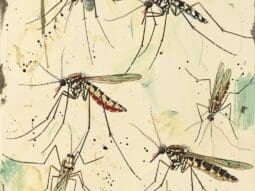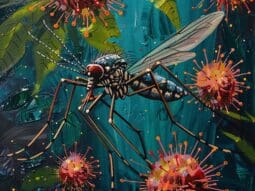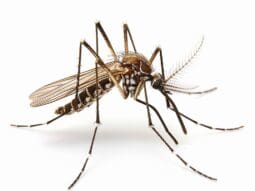
Facing an ant infestation in your home or business can be more than just a nuisance; it can disrupt your daily life and cause a significant amount of stress. Whether it's the common carpenter ant or another variety, understanding the challenge at hand is crucial. That's where professional ant control services come into play. They offer a comprehensive approach to not only eliminate current infestations but also prevent future ones, ensuring your space remains ant-free.
Professional pest control experts use the latest technology and strategies to tackle ant problems head-on. They'll identify the type of ants causing trouble, develop a tailored plan to eliminate them, and address the source of the infestation to prevent recurrence. Whether it's for a residential property or a commercial space, opting for professional ant control services means you can rest easy knowing that your ant issue is being handled effectively and efficiently.
Ant Identification and Behavior
Identifying the specific type of ant causing your infestation is a crucial step in professional ant pest control. Given the variety of ant species, each with distinct characteristics and behavior patterns, recognizing the invader guides the selection of treatment methods, ensuring efficacy and minimizing recurrence. Tools like a magnifying glass become indispensable in observing ant trails and nests, which reveal the species through physical markers and activity patterns.
Ant Species and Characteristics
Ants vary in size, color, and nesting habits, facts that professionals leverage to pinpoint the species swiftly. For example, carpenter ants, known for causing structural damage, are larger and primarily nocturnal, while pavement ants, often seen near sidewalks, are smaller and active during the day. Utilizing resources such as the Ant Identification Chart helps in contrasting these subtle differences.
Behavior Patterns
Understanding ant behavior is equally vital. Some species, like the Argentine ant, exhibit relentless foraging behavior that makes them persistent invaders of homes and businesses. Others, such as the pharaoh ant, thrive indoors, especially in warmer climates, complicating control efforts. Professionals study these patterns, alongside the ants' preferred diet, to design targeted interventions.
Active Inspection Times
Timed inspections can reveal the peak activity hours of the ant species in question. While some ants are more active at dawn or dusk, others might show a preference for nocturnal activities. This knowledge allows pest control experts to schedule treatments for maximum impact, directly hitting the ant population when it's most vulnerable.
Should identification challenges arise, professional pest control services offer the expertise to accurately diagnose the problem. Sending a picture or directly consulting with these experts not only aids in swift identification but ensures that the ant control strategy implemented is precisely tailored to the infestation at hand, ensuring a lasting solution.
Ants Common to The Southern United States
In the southern United States, certain ant species are more prevalent and, as such, pose specific challenges for homeowners. Understanding the types of ants that you might encounter can be integral to implementing successful pest control strategies. Let's delve into the species typical to Texas, Oklahoma, Louisiana, and Mississippi, alongside insights into their habits and life cycles.
Texas, Oklahoma, Louisiana, and Mississippi Ant Species
Identifying the specific species of ants in your home is crucial for effective pest control. In the southern region, several types are predominantly encountered:
- Carpenter Ants: Recognizable by their large size and preference for wood, these ants can cause significant structural damage if not addressed promptly.
- Fire Ants: Notorious for their painful stings, fire ants are a health hazard to humans and pets alike. Their aggressive nature and the welts caused by their bites make them especially dangerous.
- Pavement Ants: Though they do not pose structural threats, pavement ants can be a nuisance due to their presence in and around homes.
- Pharaoh Ants: Small and yellowish, these ants are problematic because of their ability to contaminate food sources.
For accurate identification, employing a magnifying glass can be helpful for examining ant trails and nests closely. Each species exhibits unique characteristics in terms of size, color, and behavior, which are critical to tailoring your pest control approach.
Understanding Ant Habits and Life Cycle
The behavior and life cycle of ants are essential factors in their survival and proliferation. Most ants form colonies that vary greatly in size and structure, comprising workers, soldiers, and queens. Recognizing these roles is fundamental to determining the most effective treatment methods.
The life cycle of ants progresses through four stages: egg, larva, pupa, and adult, with duration ranging from weeks to months based on species and environmental factors. Their primary motivations include the quest for food and colony protection, leading them to frequent kitchens and food storage areas.
Particularly noteworthy are their foraging patterns. Ants lay down pheromone trails to guide others to food sources, creating a potential for large scale infestations. As such, disrupting these trails or blocking their access points can serve as a potent deterrent against ant invasions in your home.
By combining knowledge of specific ant species in the southern states and their behavioral patterns, you're better equipped to tackle ant infestations effectively. Recognizing the criticality of sealing entry points and ensuring cleanliness further aligns with strategic, species-specific ant control measures. Adopting this comprehensive approach markedly improves your odds of sustaining a pest-free living environment.
Signs of an Ant Infestation
Detecting an ant infestation early can significantly improve the success of pest control efforts. Knowing the signs to look for is crucial in identifying the presence of ants in your home or business. Below are key indicators of an ant infestation that you should be aware of.
Sighting Ant Trails and Nests
One clear indication of an ant problem is the visible presence of ant trails. These trails are formed by worker ants following a chemical scent left by others in their colony, leading to and from sources of food. You might find these lines of ants moving towards small mounds or nests, which are often hidden in less conspicuous areas of your home or garden. Nests in outdoor settings may resemble small piles of soil or sand, while indoors, they might be tucked away behind baseboards, within cabinets, or underneath appliances. Discovering ant trails or nests within your residence signals a need for immediate pest control measures.
Identifying Damage to Structures
Specifically, for carpenter ants, a significant sign of infestation is damage to wooden structures within your home. These ants carve out wood to build their nests, compromising structural integrity over time. Look for fine wood shavings, resembling sawdust, near baseboards, door frames, and window sills as evidence of their activity. Tapping on wood that sounds unusually hollow might indicate the presence of a carpenter ant colony. Encountering such damage warrants prompt action to safeguard your home from further detriment.
Noticing Increased Ant Activity
An uptick in ant activity, particularly in areas related to food storage and preparation, signals a noteworthy concern. Ant infestations tend to become more apparent with the arrival of warmer weather, as ants enter homes seeking nourishment. Frequent sightings of ants around the kitchen, pantry, or food storage zones suggest an existing ant problem. It is particularly alarming if you observe various types of ants, which could imply the presence of multiple nests within your property.
Addressing these signs at the earliest ensures effective management and resolution of ant infestations. Identifying the specific ant species involved is the next critical step, allowing for the implementation of precise control strategies. This approach helps eliminate ants from your home, ensuring your peace of mind and maintaining a pest-free environment.
Ant Inspection Techniques
Effective ant control starts with a precise inspection. Understanding where to look and what to look for can make all the difference in identifying and subsequently eliminating ant infestations. By following these professionally recommended strategies, you can detect ant activities both indoors and outdoors.
Indoor Ant Search Strategy
Initiating an indoor ant search involves examining common entry points meticulously. Since ants can infiltrate through the smallest gaps, it’s essential to inspect around windows, doors, and any cracks or crevices avidly. Often, the culprits are sealant gaps or deteriorating weather stripping, offering ants easy indoor access.
Your next step should target high moisture areas like kitchens, bathrooms, and laundry rooms. Ants gravitate toward water, making these areas prime spots for activity. Focus your inspection under sinks, around dishwashers, and near any plumbing leaks for active ant trails or foraging ants that could lead you to their nest.
Don't overlook indoor plants and pet food stations, as these are appealing to ants. Regular inspection and cleanliness in these areas can mitigate ant presence. Also, examine behind appliances, in pantries, and around electrical outlets for potential unseen ant colonies.
Outdoor Inspection Tips
For outdoor inspections, commence with a comprehensive walk around your home’s perimeter, paying close attention to the foundation and areas where utility pipes enter, as ants may use these as pathways indoors.
Examine gardens, mulch beds, and dense vegetation, as these environments can attract ants to establish colonies. Look for signs of ant hills or disturbed soil, indicating underground nests. Under rocks, logs, and landscape features are also critical to inspect, as they can shelter large ant populations.
Vegetation such as tree branches and bushes touching your home’s exterior can offer ants a bridge inside. Trimming any vegetation that contacts the walls or roof is crucial in minimizing this risk.
Ensure gutters and downspouts are clear of debris to prevent attracting ants with damp conditions. Keeping gutters clean assists in deterring ant colonies from forming near or on your home.
Through diligent indoor and outdoor inspection techniques, identifying and managing ant populations becomes much more attainable. Implementing these strategies promptly and systematically plays a pivotal role in reducing the likelihood of ant infestations, ensuring a more ant-free environment.
Addressing the Ant Problem
Natural Remedies for Ant Elimination
Natural remedies serve as an excellent initial barrier against ants. Cleaning surfaces with a vinegar and water solution is a tactic many find effective. The pungent smell of vinegar not only repels ants but also obliterates their pheromone trails, hindering other ants from finding their way back to these sites. Incorporating diatomaceous earth around potential entry points and ant pathways provides a potent, yet harmless, method to eliminate ants. This non-toxic powder proves deadly to ants while remaining safe for both pets and humans, offering a prime choice for household applications.
Tips for In-House Ant Control
Focusing on prevention is key for in-house ant control. Storing food in air-tight containers and maintaining clean kitchen counters and floors are critical steps in keeping ants at bay. Addressing moisture-related issues swiftly is also essential, as ants are drawn to water sources. Sealing openings with caulk not only prevents new ants from entering but also traps existing ones, facilitating their management. By adopting these practices, you can significantly reduce the chances of an ant infestation within your home.
Strategies for Outdoor Ant Management
Effective outdoor ant management is crucial for preempting indoor infestations. Regular inspections around the perimeter of your home can reveal ant trails and nests early on. Removing debris and trimming vegetation that contacts your home are practical measures to cut off ant entry points and shelters. Utilizing borax around your home's exterior can further deter ants without adversely affecting your garden or lawn, provided you apply it carefully and sparingly.
Professional Pest Control
When ant problems grow beyond manageable levels, professional pest control services become necessary. Professionals bring in-depth knowledge, experience, and specialized equipment to accurately identify ant species, locate nests, and execute targeted treatments. These advanced interventions are particularly crucial for tackling difficult-to-eliminate species or large-scale infestations that DIY methods cannot address. Leveraging professional services when needed underscores a strategic approach to maintaining a pest-free living space.
In the battle against ants, blending natural remedies, preventative measures, outdoor management strategies, and professional pest control services forms the most comprehensive defense. Your dedication to regular monitoring, immediate action, and the strategic involvement of pest control experts positions your home as a formidable fortress against ant invasions.
Prevention of Future Ant Infestations
Preventing future ant infestations stands as a critical component of comprehensive pest control. Understanding and applying the right strategies can significantly reduce your risk of recurring ant problems. This section outlines effective preventive measures to keep your home ant-free.
Sealing Entry Points and Reducing Attractants
Eliminating entry points for ants is your first line of defense in keeping these pests out of your home. Caulking and sealing cracks, crevices, and openings around windows, doors, and utility pipes effectively minimize access for ants. A diligent approach to sealing even the smallest gaps can dramatically reduce ant intrusions.
Addressing attractants plays a key role in deterring ants from invading your living space. Storing food in airtight containers and maintaining clean countertops and floors free of crumbs and spills eliminates readily available food sources for ants. Managing moisture by promptly fixing leaks and utilizing dehumidifiers in damp areas aids in making your home less attractive to moisture-seeking ants. These straightforward steps are highly effective in creating an environment that's unwelcoming to ants.
Maintenance Tips for a Pest-Free Home
Regular maintenance is crucial for sustaining a home environment that repels ants. Trimming tree branches and bushes to prevent contact with your house removes natural pathways for ants. Addressing moisture problems, such as leaky roofs and plumbing, not only helps in ant prevention but also safeguards your home's structural integrity.
Further strategies include replacing rotted or water-damaged wood and avoiding wood-soil contact to mitigate potential nesting sites. Properly storing firewood off the ground and away from your home, and removing dead stumps, diminishes the likelihood of ant colonization. Ensuring that all food is stored securely and keeping your kitchen and dining areas meticulously clean significantly reduces ant attractants.
By combining these maintenance tips with the sealing and attractant reduction strategies, you'll form a solid foundation for preventing future ant invasions. This multi-faceted approach is instrumental in managing and preventing ant problems effectively.
Incorporating preventive measures alongside targeted interventions is proven to yield the best results in ant control. Engaging a professional pest control service like Romex Pest Control complements these efforts by providing expert assessment and environmentally safe treatments. Their two-pronged strategy of eliminating current infestations and fortifying your home against future invasions aligns perfectly with the preventive measures discussed here, ensuring your home remains an ant-free environment. Through consistent application of these strategies and leveraging professional expertise when necessary, you'll significantly enhance your defenses against ants.
Romex Pest Control
Building on your knowledge of ant species and the strategies for their control, it's paramount to consider professional options like Romex Pest Control for an all-encompassing solution. When your in-house efforts and preventive measures aren't enough, tapping into the expertise of Romex Pest Control can significantly bolster your fight against these persistent pests.
Why Choose Professional Services
Choosing professional services ensures a comprehensive approach to ant control. Romex Pest Control employs advanced techniques and tools tailored to target the specific ant species inhabiting your space. This precision not only assures effective eradication but also minimizes the chances of future infestations.
Integrated Pest Management Approach
Romex Pest Control adopts an Integrated Pest Management (IPM) approach, balancing chemical and non-chemical strategies. This method focuses on identifying the root causes of your ant problem, such as moisture issues or entry points, and addressing these alongside direct extermination. It ensures long-term solutions rather than temporary fixes.
Customized Treatment Plans
Understanding that every infestation is unique, Romex Pest Control offers customized treatment plans. After a thorough inspection of your premises, experts devise a plan that targets your specific issues. This customization is crucial for effectively tackling the nuances of your home's ant infestation.
Safety and Efficiency
Safety is a priority, and Romex Pest Control uses environmentally friendly products and methods that are safe for you, your family, and pets. Efficiency doesn't take a backseat, with swift action to eliminate ants and prevent their return, ensuring your living space returns to a pest-free state quickly.
Incorporating Romex Pest Control into your ant management strategy adds a professional layer to your efforts. Combining their expertise with your maintenance and prevention measures creates a robust defense against ants, ultimately preserving the integrity and comfort of your home.
Conclusion
Tackling ant infestations requires a strategic approach that blends knowledge, prevention, and professional intervention. Recognizing the types of ants and understanding their behavior sets the stage for effective control. While DIY methods and preventive measures are essential, they often fall short when dealing with larger or more stubborn invasions. This is where Romex Pest Control steps in. Their expertise in employing Integrated Pest Management techniques and creating customized treatment plans not only addresses your current ant problem but also helps prevent future occurrences. By choosing a professional service like Romex, you're ensuring a safer, more efficient path to a pest-free home. Remember, the key to successful ant control is a combination of your efforts and the specialized skills of professionals.
Still haven't found the information you are looking for? Provide your information below, and we will use our AI Pest Detective to provide your next steps and deliver more specifics to your inbox.
Your Journey to Pest-free
50+ Years Experience. Eco-Friendly, Pet-Friendly, and Kid-Friendly Treatments. Results Guaranteed. Romex Pest Control
Romex Pest Control is committed to protecting you, your children, and your pets with our eco-friendly, child-friendly, and pet-friendly guaranteed pest control solution.
We are confident in solving all pest, rodent, and termite problems.
Romex Pest Control is fully insured and licensed in Texas, Oklahoma, Louisiana, and Mississippi.
Established 2016 © Copyright 2024 Romex Pest Control










